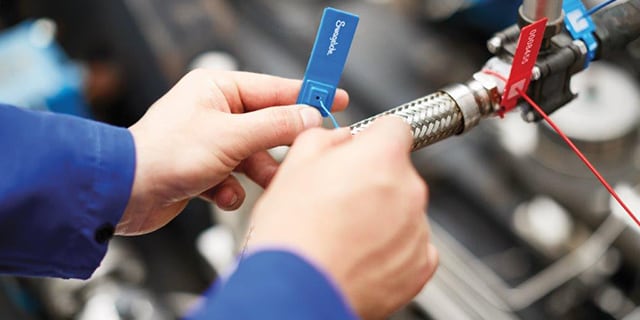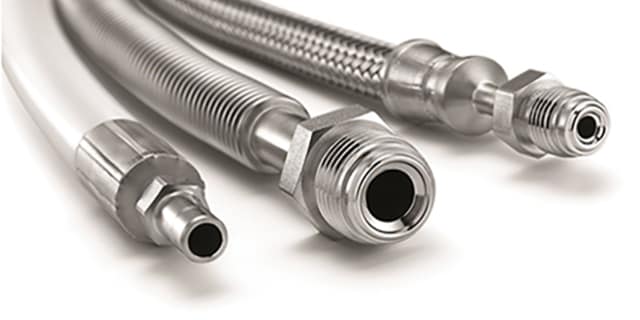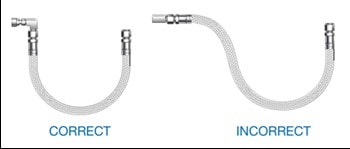3 Steps to Improve Hose Safety & Lower Plant Costs

3 Steps to Improve Hose Safety & Lower Plant Costs
Doug Nordstrom, Senior Product Manager, Hose Product Group
Industrial hoses often do not get the attention they deserve. Most manufacturing facilities have specifications and policies concerning tubing, fittings, and valves on pressure-containing systems, but hose safety continues to be left out.
This trend is alarming because hoses do fail for several different reasons. For example, they can be improperly routed, or the hose type may not correctly match the application. Even with the right setup and material selection, hoses are subject to regular wear over time. Like the tires on your car, your hoses will eventually need attention even if they are treated well—regular maintenance is a must.
It is important that leaks from hoses are taken seriously within your facility. Leaks can put plant personnel in unsafe situations, inflate operating costs, contribute to fugitive emissions, and adversely affect the environment. Luckily, your team can avoid dangerous situations and downtime while improving plant efficiency by following these three recommendations for industrial hose safety.
1. Properly Match the Hose Type to the Application
Many organizations are trying to increase the production value from their machines and processes—resulting in greater demand on industrial hoses. In cases of high demand, make sure your hose specifications for pressure, temperature and chemical compatibility are up to date and inspected regularly.
When specifying a hose, consider several areas to ensure the hose type is properly matched to its intended application. Careful selection in these areas of the hose will determine your total cost of ownership, which provides a greater lifetime value than the initial purchase price.
- Reinforcement layer — This part of the hose is usually made up of stainless steel or fiber woven braid used to improve pressure containment and flexibility. When examining the reinforcement layer, consider the hose bend radius as well as the “force to bend.” Thicker or multiple layers will increase the pressure rating of a hose, but most likely result in a stiffer, less pliable hose that will not perform as well in dynamic applications.
- Cover — The cover is the outermost layer (commonly silicone, polyurethane, or rubber) that protects underlying layers, personnel, and surrounding equipment. Ensure your cover can withstand the conditions within your plant, as it is your hoses’ first line of defense.
- End connections — The performance of your hose depends largely on your manufacturer’s ability to attach an appropriate end connection to the hose for testing. While you may have selected a proper hose and end connection, if the process for assembly is not followed, you will likely encounter leaks. Look for hose suppliers with certified assemblers and a warranty that covers leakage from the end connection.
Consider the Core Hose Material
The core material of your hose is its innermost layer and most important consideration when selecting and maintaining your hose supply. Your core hose material must be chemically compatible with the system media and be able to tolerate the temperature range, plus provide acceptable levels of permeation and absorption. Below are several common core materials used and associated benefits in industrial-grade hoses:
Metal
- Good general-purpose hose
- Widest temperature range available
- Resists permeation and absorption
- Not compatible with highly caustic or acidic system media
- Not well-suited for operations with repetitive movements or pressure impulses
Fluoropolymer (PTFE, PFA, FEP)
- Good chemical compatibility
- Highly flexible
- Easy to clean
- Low absorption
- Available with static dissipation
- Highly permeable (May permeate more than desired in some gas applications)
Silicone
- Highly flexible
- Limited chemical compatibility
- Highly absorptive
- Easy to clean
- Not robust and long-lasting in most applications
Thermoplastic (Nylon)
- Economical, general-purpose hose
- Great for hydraulic fluids
- Limited temperature range
Rubber
- Economical, general purpose hose
- Highly durable
- Available in large sizes above 2 inches
- Limited temperature and pressure range
2. Proper Hose Routing and Storage
It’s common to have the right hose for an application with an improper installation. An error Swagelok field engineers see frequently is allowing a hose to hang vertically from a horizontal end connection. In such situations, you should install a 90° elbow fitting first.
Another set of common installation errors results from improper hose length. Excessive hose length can take up unnecessary space, allowing the hose to rub against itself or a machine, accelerating wear. Alternatively, a hose can be too short and tightly stretched between two points. In this case, thermal expansion, system pressure change, or slight movement at the connection points can cause leakage at the end connection. The proper hose length will have enough slack to accommodate connection point movement, but not enough to allow for rubbing, interference, or kinking.
When storing hose, here are a few points to keep in mind:
- Store in clean, dry conditions between 50° F and 70° F (10° C to 21° C)
- Protect from UV light/sunlight
- Cap the hose at both ends to prevent contamination and keep dirt, debris and insects out of your hose
- Check for hose shelf life
- To prevent kinking, hang so the hose is not bending more than it should; look up the manufacturer’s bend radius for your hose
- Do not stack hoses
- Store coils horizontally on a surface
3. Proper Hose Maintenance
Hose failure can be predicted. Based on the hose type and its use, hoses should be checked and replaced at certain regular intervals. You do not need to wait until there is a problem or a dangerous leak to inspect your hoses.
A proper maintenance schedule should consider the specific application and hose type. Some hose types wear faster than others. In addition, these variables will lead to faster wear:
- Repetitive movement
- Vibration
- Pressure impulses
- Improper routing
Hoses are a convenient and quick way to connect two points in your fluid system but be sure to take the necessary steps to ensure safety and avoid costly downtime. Contact your local authorized Swagelok sales and service center to consult with a certified Swagelok hose advisor or to schedule hose training for your team.
Related Articles

How to Improve Your Maintenance Program with Valve and Hose Tags
Hear from two Swagelok specialists how a robust tagging system for hoses and valves throughout your industrial fluid systems can help you simplify maintenance and minimize system downtime.

How an Industrial Hose Maintenance Plan Could Save Your Plant Thousands
Knowing the proper time to replace your industrial hoses can save your plant thousands in maintenance costs. Learn how to evaluate your systems and develop a preventive maintenance plan to manage the health of your hoses.

How to Select the Right Hose Reinforcement
Industrial hoses typically contain critical reinforcement layers that contribute to longevity and performance. Learn about different reinforcement layers types and which is best suited for different fluid system applications.


